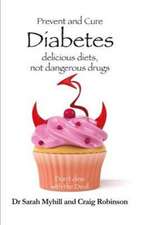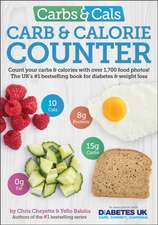Regulation of Gene Expression by Hormones: Biochemical Endocrinology
Editat de Kenneth McKernsen Limba Engleză Paperback – 15 iul 2012
Preț: 715.00 lei
Preț vechi: 752.63 lei
-5% Nou
Puncte Express: 1073
Preț estimativ în valută:
136.82€ • 143.21$ • 113.87£
136.82€ • 143.21$ • 113.87£
Carte tipărită la comandă
Livrare economică 31 martie-14 aprilie
Preluare comenzi: 021 569.72.76
Specificații
ISBN-13: 9781468444209
ISBN-10: 1468444204
Pagini: 284
Ilustrații: XII, 266 p. 44 illus.
Dimensiuni: 155 x 235 x 15 mm
Greutate: 0.4 kg
Ediția:Softcover reprint of the original 1st ed. 1983
Editura: Springer Us
Colecția Springer
Seria Biochemical Endocrinology
Locul publicării:New York, NY, United States
ISBN-10: 1468444204
Pagini: 284
Ilustrații: XII, 266 p. 44 illus.
Dimensiuni: 155 x 235 x 15 mm
Greutate: 0.4 kg
Ediția:Softcover reprint of the original 1st ed. 1983
Editura: Springer Us
Colecția Springer
Seria Biochemical Endocrinology
Locul publicării:New York, NY, United States
Public țintă
ResearchCuprins
1 Hormone Action in Human Breast Cancer: Estrogen Regulation of Specific Proteins.- 1. Introduction.- 2. Are Breast Tumors True Targets for Estrogen Action?.- 3. Estrogen-Regulated Protein Synthesis in Human Breast Cancer.- 4. Conclusions.- References.- 2 Modulation of an Estrogen-Induced Protein in the MCF7 Human Mammary Cancer Cell.- 1. Introduction.- 2. Estrogen-Induced Proteins Released by MCF7 Cells in Culture.- 3. Dissociated Effect of Nonsteroidal Antiestrogens.- 4. Altered Activation of ER by Antiestrogens.- 5. BrdU Incorporation into DNA Inhibits Estrogen-Induced Responses.- References.- 3 The Estrogen-Induced/Dependent Renal Adenocarcinoma of the Syrian Hamster.- 1. Introduction.- 2. Hypophysectomized Hamsters.- 3. Pituitary Cells in Culture.- 4. Renal Adenocarcinoma Cells in Culture.- 5. Hormone Levels in Hamster Serum.- 6. Tumorogenesis via Immunoendocrine Perturbations.- References.- 4 Stimulation of Milk-Fat Synthesis in Mammary Epithelioid Cells by Progesterone.- 1. Introduction.- 2. Materials and Methods.- 3. Results.- 4. Discussion.- References.- 5 Prolactin and Casein Gene Expression in the Mammary Cell.- 1. Introduction.- 2. The Expression of Casein Genes during Pregnancy and Lactation.- 3. Relation between Casein Synthesis and Casein mRNA Concentration.- 4. The Control of Mammary Cell Hypertrophy.- 5. The Hormonal Control of Casein mRNA Translation.- 6. Variations of Casein Gene Transcription and Casein mRNA Stability.- 7. Relation between Prolactin Receptor Occupancy and the Hormonal Response.- 8. Action of Antiprolactin Receptor Antibodies.- 9. Role of Tubulin-Containing Structures in the Transmission of the Prolactin Message to Casein Genes.- 10. Identification of a Possible Second Messenger for Prolactin.- 11. Conclusions.- References.- 6 Sequential Regulation of Gene Expression by Estrogen in the Developing Rat Uterus.- 1. Introduction.- 2. Sequential Development of Estrogen Responsiveness.- 3. Estrogen-Responsive Creatine Kinase.- 4. Regulation of Glucose-6-Phosphate Dehydrogenase.- 5. Considerations for Future Study.- References.- 7 Estrogen-Induced Uterine Hypertrophy.- 1. Introduction.- 2. Estradiol-17?-Stimulated Uterine Hypertrophy.- 3. Estrogen-Stimulated hnRNA Synthesis and Its Maturation to mRNA.- 4. Studies on the mRNA Population of the Rat Uterus.- 5. Estrogen-Stimulated rRNA and tRNA Synthesis.- 6. The Nature of the Proteins on Which Stimulated Ribosome Production Might Depend.- 7. Investigation of the Mode of Action of the Antiestrogen, Tamoxifen.- References.- 8 Regulation of the Expression of the Uteroglobin Gene by Ovarian Hormones.- 1. Introduction.- 2. Structure and Function of Uteroglobin.- 3. Distribution of Uteroglobin and Differential Hormonal Control.- 4. Hormonal Regulation of Uteroglobin Synthesis: Studies with Isolated Uteri, Endometrial Explants, and Endometrial Cell Cultures.- 5. Characterization of Uteroglobin mRNA and Cell-Free Translation Experiments.- 6. Titration of Uteroglobin mRNA by Molecular Hybridization.- 7. Involvement of the Progesterone Receptor.- 8. Hormonal Regulation of Transcription of the Uteroglobin Gene.- 9. Cloning and Characterization of Uteroglobin cDNA.- 10. Quantitation, Isolation, and Structural Analysis of the Uteroglobin Gene.- 11. Concluding Remarks.- References.- 9 Evolution and Regulation of Genes for Growth Hormone and Prolactin.- 1. Evolution.- 2. Regulation.- References.- 10 Androgenic Control of Gene Expression in Rat Ventral Prostate.- 1. Introduction.- 2. Cloning of Rat Ventral Prostate cDNAs.- 3. Expression of RNA in Ventral Prostate.- 4.Isolation of Prostatic-Binding Protein Genomic Clones.- 5. Characterization of Prostatic-Binding Protein Genes.- 6. Future Prospects.- References.- 11 Effects of Ovarian Steroid Hormones on the Brain and Hypophysis: Receptor Modulation and Chromatin Binding.- 1. Hormonal Modulation of Estrogen and Progesterone Receptors in the Rat Brain.- 2. Chromatin Binding in the Brain and Hypophysis.- 3. Summary and Conclusion.- References.- 12 A Cellular Polyprotein from Bovine Hypothalamus: Structural Elucidation of the Precursor to the Nonapeptide Hormone Arginine Vasopressin.- 1. Introduction.- 2. Structural Organization of the AVP—NP II Precursor.- 3. Primary Structure of the AVP—NP II Common Precursor.- 4. Glycine as Signal for Amidation of Oligopeptides.- 5. The 18K Precursor.- 6. Concluding Remarks.- References.



















